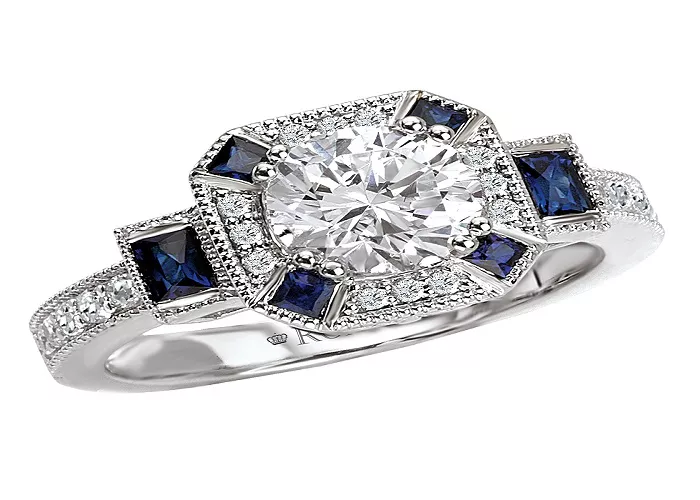A sapphire ring is a stunning piece of jewelry that never goes out of style. Known for its deep blue hue, durability, and royal appeal, the sapphire has been cherished for centuries. Whether set in an engagement ring, a fashion statement piece, or a family heirloom, sapphire rings carry elegance and meaning.
In this guide, we will explore what sapphires are and why they are special, the different types of sapphires, popular sapphire ring styles and settings, how to choose the best sapphire ring, and how to care for your sapphire ring. By the end, you will know everything you need to make an informed decision when buying or wearing a sapphire ring.
What Is a Sapphire?
A sapphire is a precious gemstone from the mineral corundum. While most people think of sapphires as blue, they actually come in many colors—except red, as red corundum is called ruby.
Sapphires are valued for several reasons. Their hardness ranks 9 on the Mohs hardness scale, just below diamonds, making them extremely durable for daily wear. Their excellent light refraction gives them a beautiful sparkle. Additionally, sapphires symbolize wisdom, loyalty, and nobility.
There are natural sapphires, which are mined from the earth and can be rare, especially in high quality, and lab-grown sapphires, which have the same chemical properties but are more affordable and eco-friendly.
Types of Sapphires
Sapphires come in many colors, each with unique charm.
Blue sapphires are the most classic and sought-after variety. The finest blue sapphires come from Kashmir, Burma, and Sri Lanka, with colors ranging from light blue to deep royal blue.
Pink sapphires are a romantic and feminine choice, often used in engagement rings. Yellow sapphires are bright and cheerful, symbolizing prosperity, and are often used as a diamond alternative.
Padparadscha sapphires are a rare pink-orange variety, highly prized by collectors. White sapphires, also known as colorless sapphires, serve as a diamond alternative with great sparkle.
Green and purple sapphires are unique and less common, offering a distinctive look. Star sapphires display a star-like effect when light hits them and are usually cut in smooth, rounded cabochon shapes.
Popular Sapphire Ring Styles
Sapphires are versatile and can be set in many ring designs.
Sapphire engagement rings are a timeless alternative to diamonds. The iconic blue sapphire engagement rings of Princess Diana and Kate Middleton made this style famous. These rings are often set in white gold or platinum for contrast.
Sapphire and diamond rings combine the beauty of both gems. Common designs include halo rings, where a sapphire center is surrounded by diamonds, three-stone rings symbolizing past, present, and future, and pave bands with small diamonds along the band.
Vintage and antique sapphire rings feature intricate metalwork, often with milgrain detailing and filigree patterns from Victorian, Art Deco, or Edwardian eras.
Men’s sapphire rings tend to have bold designs with dark blue or black sapphires, often set in tungsten, titanium, or sterling silver.
Sapphire birthstone rings are meaningful gifts, especially for those born in September, as sapphire is the traditional birthstone for that month.
Choosing the Best Sapphire Ring
When buying a sapphire ring, consider the four key factors: color, clarity, cut, and carat.
Color is the most important factor for sapphires. The best blue sapphires have a medium to deep blue hue with slight violet undertones, like those from Kashmir. Avoid stones that are too dark or too light.
Clarity refers to the presence of inclusions, or natural flaws. Eye-clean stones, with no visible flaws to the naked eye, are ideal.
The cut of a sapphire affects its brilliance. Common cuts include oval, round, cushion, emerald, and pear. Star sapphires are usually cabochon-cut.
Carat refers to the size of the sapphire. Larger sapphires are rarer and more expensive, but a well-cut sapphire can appear larger than its carat weight suggests.
The choice of metal also impacts the ring’s appearance. White gold or platinum enhances blue sapphires, while yellow or rose gold complements pink and yellow sapphires.
Budget considerations vary widely. Natural sapphires can range from 10,000 depending on quality, while lab-grown sapphires are more affordable, typically costing between 2,000.
Caring for Your Sapphire Ring
Sapphires are durable but still require proper care to maintain their beauty.
Cleaning your sapphire ring is simple. Use warm soapy water and a soft brush to gently clean the stone. Avoid harsh chemicals like bleach or chlorine, as they can damage the metal setting. Ultrasonic cleaners are generally safe unless the stone has fractures.
Storage is also important. Store your sapphire ring separately to prevent scratches, using a soft pouch or jewelry box.
Regular maintenance ensures longevity. Have the prongs checked annually to prevent stone loss, and consider professional cleaning every six to twelve months.
Conclusion
A sapphire ring is a perfect blend of beauty, durability, and meaning. Whether you prefer a deep blue classic or a rare pink-orange padparadscha, there’s a sapphire ring for every taste. By understanding the types, styles, and quality factors, you can choose a ring that will last a lifetime.
If you’re looking for elegance with a touch of royalty, a sapphire ring is an excellent choice. Its timeless appeal ensures it will remain a cherished piece for generations.
Related Topics:
- Discovering Sapphire Sources in India: A Complete Guide
- Women’s Lab-Created Blue Sapphire Sterling Silver Cocktail Ring
- Where to Wear Your Blue Sapphire Ring: A Guide for Women


